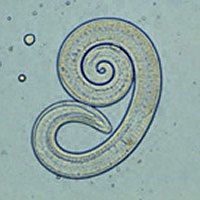
Photo from wikipedia
Carnivore and omnivore animals are the main reservoir hosts of nematodes of the genus Trichinella. Out of the twelve taxa identified so far in the world, four, namely Trichinella spiralis,… Click to show full abstract
Carnivore and omnivore animals are the main reservoir hosts of nematodes of the genus Trichinella. Out of the twelve taxa identified so far in the world, four, namely Trichinella spiralis, Trichinella nativa, Trichinella britovi and Trichinella pseudospiralis, are circulating in Europe. All these four species were detected in Finnish wild animals and T. spiralis also in domestic pigs and synanthropic rats of Finland up to 2004, when the last T. spiralis infection was documented in a domestic pig. In the periods 1993-1997 and 1999-2005, T. spiralis was detected in 13.6% (6/44) and in 14.5% (46/317) of infected wild animals, respectively. The aims of the present study were to investigate the prevalence of Trichinella spp., especially T. spiralis in wild carnivores of Finland, 7-9 years after the eradication of Trichinella infection from Finnish domestic pigs, and to evaluate the impact of the disappearance of domestic cycle of T. spiralis on the sylvatic Trichinella cycle(s). Trichinella spp. larvae were detected in 34.7% (1081/3112) wild animals and 835 (77.2%) Trichinella spp. isolates were identified at the species level. Trichinella spiralis was detected in 9 animals (1.0% of identified infections) as single, double or triple infections; whereas, T. spiralis had been detected in 13.6% and in 14.5% of infected wild animals in the course of the two previous investigations. The reduction of T. spiralis prevalence from 1993-1997 to 2011-2013 is statistically significant (p < 0.001) both per total tested animals and per host species. The results of this study support the hypothesis of spillover from domestic pigs as a source of T. spiralis in wildlife. The eradication of T. spiralis from the domestic cycle in Finland in 2004 has probably established a virtuous cycle reducing the prevalence of this pathogen among wild carnivores. We can expect that within some years and in absence of T. spiralis reintroduction in the domestic habitat, it might even disappear from the Finnish wildlife.
Journal Title: Veterinary parasitology
Year Published: 2018
Link to full text (if available)
Share on Social Media: Sign Up to like & get
recommendations!